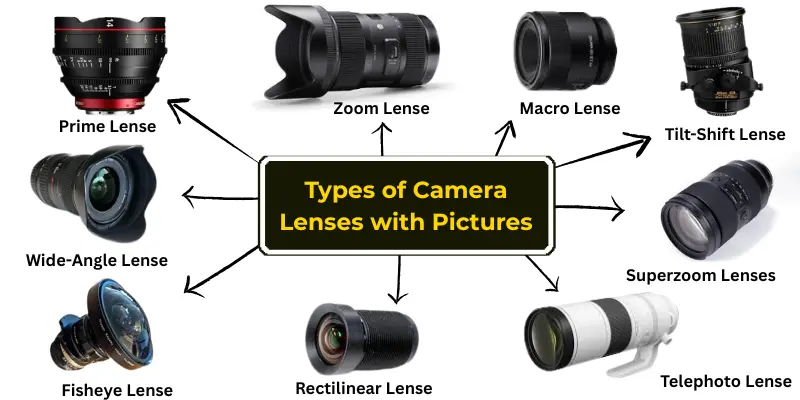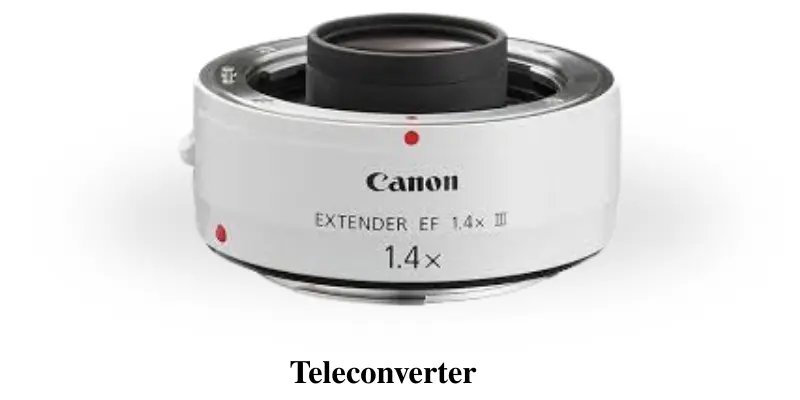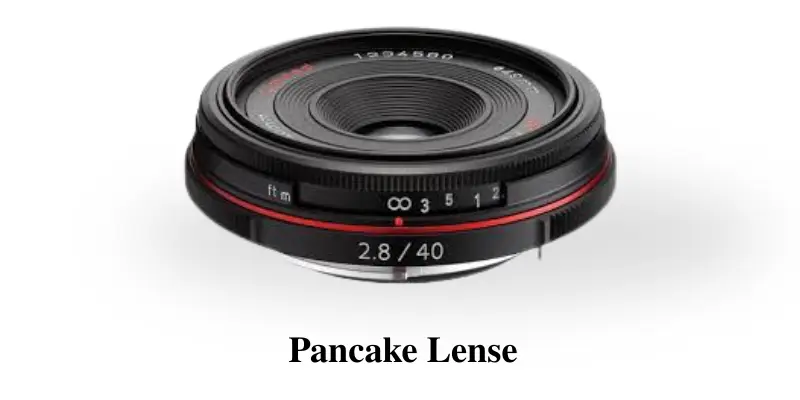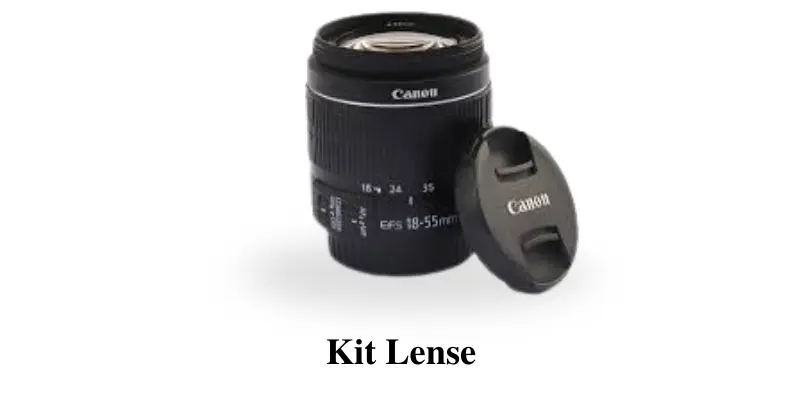Different Types of Camera Lenses
Published: 30 Jun 2025
Choosing the right camera lens can significantly impact your photography. Whether you’re capturing a landscape, a portrait, or a detailed macro shot, the type of lens you use can make all the difference.
In this article, we’ll take a detailed look at the various types of camera lenses, explore their characteristics, and help you understand how to choose the best one for your photography style. So, let’s dive in.

1. Prime Lenses
A prime lens has a fixed focal length, meaning it doesn’t zoom in or out. This limitation can actually be beneficial because it forces photographers to focus more on their subjects and framing. Prime lenses are known for their sharpness, low-light performance, and the ability to achieve a beautiful bokeh (the blurry background effect that makes your subject pop).
| Pros: |
|---|
|
| Cons: |
|---|
|
Best For:
- Portrait photography, due to its wide apertures (f/1.2, f/1.4), creates a dreamy background blur.
- Street photography, with its fixed focal lengths, forces you to move around to capture your shot, encouraging creativity.
2. Standard Lenses
Standard lenses usually have a focal length of around 50mm, which is close to what the human eye naturally sees. That’s why photos taken with these lenses look very natural and balanced.
| Pros: |
|---|
|
| Cons: |
|---|
|
Best For:
- Everyday photography (people, places, objects)
- Portraits with a natural look
- Travel and street photography
3. Zoom Lenses
A zoom lens allows you to adjust the focal length, giving you the flexibility to frame your shot without needing to move. This makes zoom lenses extremely versatile. You can go from wide shots to close-ups without changing lenses.
| Pros: |
|---|
|
| Cons: |
|---|
|
Best For:
- Travel photography, where you may need to switch between wide-angle and telephoto shots quickly.
- Event photography, like weddings, where you need to adjust between close-up portraits and wide group shots quickly.
4. Macro Lenses
A macro lens is specifically designed for extreme close-up photography, allowing you to capture fine details of small objects. If you’re interested in photographing flowers, insects, or even jewelry, a macro lens can help you get that incredible detail.
| Pros: |
|---|
|
| Cons: |
|---|
|
Best For:
- Close-up shots of small objects, such as flowers, insects, or textures.
5. Telephoto Lenses
A telephoto lens has a longer focal length (typically 70mm and above), allowing you to photograph subjects at a distance. These lenses are perfect for shooting wildlife, sports, or any scenario where getting physically close to the subject isn’t possible.
| Pros: |
|---|
|
| Cons: |
|---|
|
Best For:
- Wildlife photography, capturing animals without disturbing them.
- Sports photography, allowing you to zoom in on fast-moving subjects from a distance.
6. Wide-Angle Lenses
A wide-angle lens typically has a focal length of 35mm or lower, offering a broader field of view. These lenses are perfect for capturing wide landscapes or large architectural structures where you need to fit a lot of the scene into the frame.
| Pros: |
|---|
|
| Cons: |
|---|
|
Best For:
- Landscape photography, where capturing broad scenes is key.
- Architecture photography, allowing you to capture wide buildings and structures.
7. Ultra-Wide-Angle Lenses
Ultra-wide-angle lenses have a focal length of 24mm or less, giving you a much broader view than standard wide-angle lenses. They offer a unique, sometimes dramatic view, perfect for certain types of shots.
| Pros: |
|---|
|
| Cons: |
|---|
It can cause distortion, especially when shooting straight lines like buildings or horizons. |
Best For:
- Dramatic landscapes and cityscapes.
- Creative photos with interesting perspectives.
8. Superzoom Lenses
A superzoom lens offers an extremely wide focal length range, allowing you to shoot from a wide angle to telephoto without changing lenses. While they might not have the same image quality as prime or specialized zoom lenses, they offer great convenience.
| Pros: |
|---|
|
| Cons: |
|---|
|
Best For:
- Travel photography, where you don’t want to carry multiple lenses.
- Street photography, for capturing different scenes without the need to change lenses.
9. Tilt-Shift Lenses
A tilt-shift lens allows you to control the plane of focus and perspective. This lens is commonly used in architectural photography to prevent distortion and in creative photography to produce a “miniature” effect.
| Pros: |
|---|
|
| Cons: |
|---|
|
Best For:
- Architecture and real estate photography, where maintaining straight lines is essential.
- Creative photography, such as the miniature effect.
10. Fisheye Lenses
A fisheye lens is an ultra-wide-angle lens that creates a distinct, circular image with heavy distortion. This lens provides a unique, almost unreal effect, making it a fun tool for creative photography.
| Pros: |
|---|
|
| Cons: |
|---|
Distortion may not be suitable for all types of photography. |
Best For:
- Creative or experimental photography.
- Capturing ultra-wide panoramic views from a unique angle.
11. Teleconverters
A teleconverter is a small accessory that attaches between your camera body and lens. It effectively increases the focal length of your lens, making it function like a longer lens.

For example, if you have a 100mm lens and use a 2x teleconverter, your lens will behave like a 200mm lens. This allows you to capture distant subjects without having to purchase a more expensive, dedicated telephoto lens.
| Pros: |
|---|
|
| Cons: |
|---|
|
Best For:
- Extending the reach of your existing telephoto lens.
- Wildlife and sports photography when you need more zoom.
12. Rectilinear Lenses
Rectilinear lenses are designed to correct optical distortion, especially in wide-angle shots. Unlike fisheye lenses, they maintain straight lines and a natural perspective, making them perfect for capturing architectural details and landscapes.
| Pros: |
|---|
|
| Cons: |
|---|
|
Best For:
- Architectural photography, where maintaining straight lines is important.
- Landscape photography, especially wide shots, where perspective correction is needed.
13. Pancake Lenses
Pancake lenses are compact, lightweight lenses with a very short focal length and a slim, pancake-like design. Despite their small size, they still offer great image quality, making them an excellent choice for photographers looking for portability without sacrificing performance.

| Pros: |
|---|
|
| Cons: |
|---|
|
Best For:
- Street photography and travel photography, where carrying light gear is crucial.
- Everyday shooting, where you need a small, discreet lens for spontaneous shots.
14. Kit Lenses
Kit lenses are the standard zoom lenses that come included when you buy a new DSLR or mirrorless camera. They usually have a variable focal length, like 18-55mm, which means you can zoom in and out from wide-angle shots to slightly zoomed-in views.

These lenses are made to give beginners a good starting point. They allow you to try different types of photography (like landscapes, portraits, or close-ups) without needing to buy extra lenses right away.
| Pros: |
|---|
|
| Cons: |
|---|
|
Best For:
- Beginners who are just starting with photography
- Everyday photography like travel, portraits, or nature
- Trying different zoom levels to learn what suits your style
How to Choose the Right Lens for Your Photography Style
Choosing the right lens depends on what and how you love to shoot. Each lens has its strengths, and matching it to your photography style will help you get the best results. Here’s a quick tip to help you make the right choice:
- Portrait Photography: If you want to capture great portraits, a prime lens with a wide aperture (f/1.2 or f/1.4) is perfect. It creates a beautiful background blur (bokeh) and ensures sharp focus on the subject. A 50mm or 85mm lens is highly recommended.
- Landscape Photography: For extensive landscapes, a wide-angle lens (with a focal length of 35mm or lower) will give you a broad field of view to capture the beauty of nature. An ultra-wide-angle lens (24mm or below) can be used for dramatic wide shots of scenery.
- Macro Photography: If you’re fascinated by tiny details, such as flowers or insects, a macro lens will give you the ability to get super close and capture fine textures and complex details.
- Travel & Street Photography: For flexibility and ease of use, a zoom lens (18-55mm) is perfect. It allows you to quickly switch from wide-angle shots to zoomed-in views, making it perfect for unpredictable street scenes or capturing moments while traveling.
- Wildlife & Sports Photography: A telephoto lens (70mm or above) allows you to shoot distant subjects, such as animals or athletes, without disturbing them. It’s perfect for isolating subjects from a distance with great detail.
- Everyday Use: A standard lens (50mm) is a great all-around choice for everyday photography. It copies the human eye’s perspective and is great for portraits, travel, and general shots.
| 💡 Helpful Tips Before You Choose a Lens: |
|---|
|
Conclusion
Understanding the different types of camera lenses is essential for any photographer, whether you’re just starting out or want to expand your knowledge. Each lens has its unique characteristics and uses, so knowing when and how to use them will help you take your photography to the next level.
Remember, there is no one-size-fits-all lens, and the key is to choose the best lens for your camera that suits your style and needs. Take the time to explore the different lens types and experiment to find what works best for your personal style.
Happy shooting!
Frequently Asked Questions (FAQs)
Here are answers to some of the most common questions about the different kinds of camera lenses:
A lens on a camera is an important component that focuses light onto the camera’s sensor to capture images. It consists of multiple glass elements that help in adjusting the focus, aperture, and zoom. Without a lens, a camera cannot properly capture or focus light to produce an image.
Each camera lens type has a specific function. For instance, a wide-angle lens captures expansive scenes like landscapes, while a telephoto lens allows you to shoot distant subjects. A macro lens excels at extreme close-ups, and a standard lens offers a natural field of view, ideal for everyday shots.
The best lens for portrait photography is typically a prime lens with a wide aperture (such as 50mm or 85mm f/1.4). This allows for beautiful background blur (bokeh) and sharp focus on your subject. Prime lenses are known for their ability to create professional-looking portraits with a natural look.
The 6 most common types of camera lenses are:
- Prime Lenses – Fixed focal length lenses are known for their sharpness and low-light performance.
- Zoom Lenses – Lenses that allow you to change focal lengths, providing flexibility.
- Macro Lenses – Designed for extreme close-up photography, capturing minor details.
- Telephoto Lenses – Lenses with a long focal length for photographing distant subjects.
- Wide-Angle Lenses – Lenses with a short focal length designed for capturing wide scenes, such as landscapes.
- Fisheye Lenses – Ultra-wide-angle lenses that produce dramatic, distorted, and circular images.
The 24-70mm lens is considered a versatile “all-in-one” lens, perfect for a wide range of photography styles. It covers a wide range of focal lengths, from wide-angle to short telephoto, making it ideal for portraits, landscapes, and events. It offers both flexibility and high-quality images, which is why it’s a popular choice for many photographers.

- Be Respectful
- Stay Relevant
- Stay Positive
- True Feedback
- Encourage Discussion
- Avoid Spamming
- No Fake News
- Don't Copy-Paste
- No Personal Attacks

- Be Respectful
- Stay Relevant
- Stay Positive
- True Feedback
- Encourage Discussion
- Avoid Spamming
- No Fake News
- Don't Copy-Paste
- No Personal Attacks





